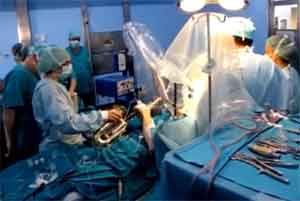- Home
- Editorial
- News
- Practice Guidelines
- Anesthesiology Guidelines
- Cancer Guidelines
- Cardiac Sciences Guidelines
- Critical Care Guidelines
- Dentistry Guidelines
- Dermatology Guidelines
- Diabetes and Endo Guidelines
- Diagnostics Guidelines
- ENT Guidelines
- Featured Practice Guidelines
- Gastroenterology Guidelines
- Geriatrics Guidelines
- Medicine Guidelines
- Nephrology Guidelines
- Neurosciences Guidelines
- Obs and Gynae Guidelines
- Ophthalmology Guidelines
- Orthopaedics Guidelines
- Paediatrics Guidelines
- Psychiatry Guidelines
- Pulmonology Guidelines
- Radiology Guidelines
- Surgery Guidelines
- Urology Guidelines
Patient plays saxophone while surgeons remove brain tumor

In an unusual surgery, a team of doctors in the US successfully removed a brain tumour from a patient while he played a saxophone in the operating room.
Dan Fabbio was serving as a music teacher in a school in New York and working for his Master's degree in music education when he was told he had a brain tumour.
"I was 25 at the time and I don't think there is any age when it is OK to hear that," said Fabbio.
Although the tumour was not cancerous, it was located in a region that is known to be important for music function.
"When I met Dan for the first time, he expressed how concerned he was about losing his musical ability, because this frankly was the most important thing to him in his life, not only his livelihood, but his profession and his interest in life," said neurosurgeon Web Pilcher, from Del Monte Institute for Neuroscience at the University of Rochester Medical Centre in the US.
"Removing a tumour from the brain can have significant consequences depending upon its location," said Pilcher. "Both the tumour itself and the operation to remove it can damage tissue and disrupt communication between different parts of the brain," he said.
"It is, therefore, critical to understand as much as you can about each individual patient before you bring them into the operating room so we can perform the procedure without causing damage to parts of the brain that are important to that person's life and function," he added.
 image source: upi.com
image source: upi.comThe doctors developed a series of cognitive musical tests that Fabbio could perform while the researchers were scanning his brain. During functional MRI (fMRI) scanning, Fabbio would listen to and then hum back a series of short melodies. He also performed language tasks that required him to identify objects and repeat sentences.
The fMRI detects changes in oxygen levels, so the parts of the brain that were activated during the tests helped pinpoint the areas important for music and language processing.
Using this information the research team produced a highly detailed 3D map of Fabbio's brain - with both the location of the tumour and music function - that would be used to help guide the surgeons in the operating room.
The ability to process and repeat a tune was an important measure, but the team also wanted to know if they were successful in preserving Fabbio's ability to perform music.
So they decided to bring his saxophone into the operating room and have him play it during the procedure. The challenge was the pressure caused by the deep breathes required to play long notes on the saxophone could cause the brain, which would be exposed during the procedure, to protrude from his skull. The doctors ultimately selected a piece - a version of a Korean folk song - that could be modified to be played with shorter and shallower breaths.
During the procedure, the surgical team used the map of Fabbio's brain to plan the surgery. They also went through a process of reconfirming what the brain scans showed them. This was done by delivering a mild electrical stimulus that temporarily disrupts a small area of the brain.
During the procedure Fabbio was awake and repeating the humming and language tasks he performed prior to the surgery. A music professor was present in the operating room and scored Fabbio's performance to let the surgeons know whether or not they had targeted an area that disrupted music processing and, therefore, should be avoided during the procedure.

Disclaimer: This site is primarily intended for healthcare professionals. Any content/information on this website does not replace the advice of medical and/or health professionals and should not be construed as medical/diagnostic advice/endorsement or prescription. Use of this site is subject to our terms of use, privacy policy, advertisement policy. © 2020 Minerva Medical Treatment Pvt Ltd